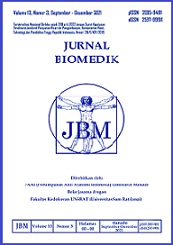THE IMPACT OF METABOLIC SYNDROME ON RADIAL ARTERY DIAMETERS
DOI:
https://doi.org/10.35790/jbm.5.2.2013.2593Abstract
Abstrak: Dewasa ini akses arteri radialis telah digunakan secara luas pada intervensi koroner transkateter. Pada pasien sindroma metabolik (MetS) yang berisiko tinggi diabetes melitus tipe 2 (DMT2), proses aterosklerosis sistemik telah memengaruhi struktur arteri radialis. Penelitian ini bertujuan untuk menentukan faktor-faktor yang berpengaruh terhadap diameter arteri radialis pada pasien MetS. Penelitian ini bersifat prospektif dan dilaksanakan di Laboratorium Kateterisasi Rumah Sakit Awal Bros Makassar sejak 1 Januari sampai dengan 15 Ferbuari 2013 (45 hari). Hasil penelitian memperlihatkan bahwa dari 40 pasien yang menjalani prosedur angiografi koroner melalui akses transradial, 22 di antaranya (55%) menyandang MetS. Rerata diameter arteri radialis pada kelompok pasien MetS dan non-MetS ialah 2,13 mm dan 2 mm. Lingkar pinggang, lingkar pergelangan, kolesterol total, HDL-C, dan trigliserida berbeda secara bermakna antara kedua kelompok. Analisis statistik dengan regresi linear menunjukkan korelasi bermakna antara diameter arteri radialis terhadap usia saja (r = 0,185;Â P < 0,05). Simpulan: Terdapat korelasi bermakna antara diameter arteri radialis dengan usia, dan tidak dengan faktor lainnya.
Kata kunci: diameter arteri radialis, sindroma metabolik.
Â
Â
Abstract: Nowadays, radial artery access is widely used as a route for transcatheter coronary interventions. Albeit, in metabolic syndrome (MetS) patients who are at high risks of developing type 2 diabetes mellitus, the systemic atheroslerosis process may have influenced the radial artery structures. This study aimed to determine factors that might influence the radial artery diameters in MetS patients. This was a prospective study conducted in the Catheterization Laboratory Awal Bros Hospital Makassar from 1st January until 15th Febuary 2013 (45 days). The results showed that in this study there were 40 consecutive patients who underwent coronary angiography procedures using the transradial apporach, of these 22 patients (55%) were with MetS. The mean radial artery diameters in MetS and non-MetS patients were 2.13 mm and 2 mm, respectively. The waist circumference, wrist circumference, total cholesterol, HDL-C, and triglyceride were significantly different between the two groups. The data were analyzed by using a  linear regression resulting in radial artery diameters (RAD) which were significantly and positively correlated only with age among the MetS subjects (r = 0.185, P < 0.05). Conclusion: Among the metabolic syndrome patients radial artery diameters were only significantly correlated to ages, and not other factors.
Keywords: radial artery diameter, metabolic syndrome.Downloads
Issue
Section
License
Penyunting menerima sumbangan tulisan yang BELUM PERNAH diterbitkan dalam media lain. Naskah yang masuk dievaluasi dan disunting keseragaman format istilah dan cara penulisan sesuai dengan format penulisan yang terlampir dalam jurnal ini.
Segala isi dan permasalahan mengenai tulisan yang yang diterbitkan dalam jurnal menjadi tanggung jawab penuh dari penulis.







